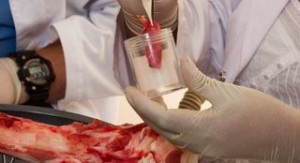Every hour of every day people around the world are living with and working to resolve food safety issues. Here is a sampling of current headlines for your consumption, brought to you today with the support of iwaspoisoned.com.
 Scientists target pathogens with research
Scientists target pathogens with research
The invention of a new small plastic pouch that releases chlorine dioxide gas to eliminate E. coli and other pathogens from the surfaces of fruits and vegetables is among the new nutrition and health findings in the latest issue of the USDA’s Agricultural Research Service food and nutrition research briefs.
Among other findings, the current issue reports on:
- A new vaccine developed by ARS scientists that can protect food animals such as pigs and turkeys against both human- and animal disease-causing Salmonella. In experiments, the vaccine protected pigs against two types of Salmonella-Typhimurium and Choleraesuis. It also protected turkeys against Typhimurium and the multidrug-resistant Salmonella type, Heidelberg.
- ARS scientists development of a new infrared technology that can improve commercial food processing, particularly drying of walnuts. Drying walnuts by the current hot-air method is expensive and energy intensive. This infrared method dries walnuts with 25 percent less energy and reduces drying time by 35 percent. It also may be practical for other types of nuts, such as pistachios.
- A heat-tolerant broccoli that could be on the horizon since ARS scientists have identified genetic markers associated with heat resistance and characterized the genetic sources of broccoli’s ability to tolerate heat stress. Encountering high temperatures is the main factor limiting where and when broccoli is grown. One cup of broccoli provides more than 100 percent of our daily requirement for vitamins C and K and is a good source of fiber, vitamin A, folate and potassium.
 FSIS expands testing for pesticides
FSIS expands testing for pesticides
Beginning Feb. 26, the Food Safety and Inspection Service (FSIS) will expand its testing for pesticides on foods under the jurisdiction of its parent agency, the U.S. Department of Agriculture.
When the updates to the FSIS Chemistry Laboratory Guidebook take effect, the agency will be able to detect 108 different pesticides in the muscle tissue of beef, pork, poultry, sheep, goat, horse, catfish, and liquid and powdered egg products.
The Chemistry Laboratory Guidebook (CLG) contains test methods used by FSIS laboratories to support the USDA’s inspection program, which is designed to ensure the safety of meat, poultry and processed egg products.
“The CLG contains methods for the analysis of food composition, food additives, nutrients, veterinary drug and pesticide residues,” according to a news release from FSIS. “Methods are designed to provide analysts with written documentation to facilitate training, performance, quality assessment, and interpretation of data.”
Complete details on the method are available by clicking here.
 Salmonella chicken in the Holy Land
Salmonella chicken in the Holy Land
Attorneys representing consumer groups are seeking approval from Israeli courts for a huge class-action lawsuit against some of the country’s largest supermarket chains for selling tainted chicken.
The lawsuit cites statistics of recent veterinary studies that established high levels of Salmonella. At the Shufersal supermarkets checked, 55 percent of the chickens c
arried the pathogen, as did 55 percent of the Yeinot Bitan chickens. At Rami Levy, 27 percent of the chickens were contaminated with Salmonella.
According to the lawsuit, the grocery chains are selling contaminated chickens without providing warnings that they may be infected – and as such should be held responsible for cases in which people who ate their chickens got sick.
Salmonella can be killed if the chicken is cooked to at least 160 degrees F. Nevertheless, there is a danger that some people will not cook the chicken properly, according to Shai Shulman, on whose behalf the lawsuit is being filed.
“Salmonella can harm and hurt my children, whose internal defenses may not be able to beat back the germs,” he told Hadashot News. “When I realized this I felt a great deal of pressure. (In addition) the infected chicken infects other foods, and the entire kitchen environment, when you bring it home,” he said.
(To sign up for a free subscription to Food Safety News, click here.)

